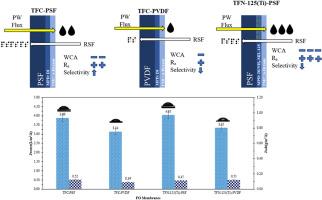探讨表面工程钛填料膜用于采出水处理的潜力
IF 6.8
3区 材料科学
Q1 MATERIALS SCIENCE, MULTIDISCIPLINARY
Journal of Science: Advanced Materials and Devices
Pub Date : 2025-06-07
DOI:10.1016/j.jsamd.2025.100922
引用次数: 0
摘要
在油气开采过程中,采出水与原油一起出现,采出水的处理和再利用减少了对淡水的依赖。处理后的采出水随后可用于水驱活动,以提高采收率,延长油田的使用寿命。薄膜复合膜(TFC)与正向渗透(FO)技术相结合,为处理采出水提供了一种很有前途的方法,同时具有成本效益和能源效率。在本研究中,MIL-125(Ti) -NH2在界面聚合反应中用于制备钛基薄膜纳米复合材料(TFN) FO膜。研究了表面工程对制备膜的润湿性、形貌和表面粗糙度等特性的影响,如成孔剂的加入、界面聚合反应和填料的包裹。结果表明,在单体聚合反应后,TFC/TFN膜的接触角显著降低(高达33%),表面粗糙度增加(约31%),表明选择性层的形成导致TFC/TFN膜具有更高的亲水性以及聚合物与填料之间的良好相容性。此外,钛基填料的加入使FO膜的水通量提高了240%,并且由于水分子与-NH2基团之间的非共价键降低了比反盐通量。因此,该研究通过揭示钛基TFN膜在处理油田采出水和在水驱活动中重复使用以提高采收率方面的潜力,为未来的研究提供了框架。本文章由计算机程序翻译,如有差异,请以英文原文为准。

Probing the potential of surface-engineered titanium filler membranes for produced water treatment
The treatment and reuse of produced water, which emerges with crude oil during extraction in oil and gas operations, reduces dependency on freshwater. The treated produced water can subsequently be used in water flooding activity for enhanced oil recovery, extending the life of the oilfield. Thin-film composite (TFC) membranes, in conjunction with forward osmosis (FO) technology, provide a promising approach for treating the produced water, offering both cost-effectiveness and energy efficiency. In this study, MIL-125(Ti)–NH2 is used during an interfacial polymerization reaction for fabricating titanium-based thin film nanocomposite (TFN) FO membrane. The effects of surface engineering, such as pore-forming agent addition, interfacial polymerization reaction, and filler inclusion, on the features of fabricated membranes, such as wettability, morphology, and surface roughness, were examined. The results show a significant reduction in contact angles (up to 33 %) and an increase in surface roughness (by approximately 31 %) after the monomer polymerization reaction, indicating that the formation of a selective layer resulted in higher hydrophilicity of the TFC/TFN membranes as well as good compatibility between polymer and fillers. Furthermore, the addition of titanium-based fillers improved FO membrane water flux by 240 % and lowered the specific reverse salt flux due to the non-covalent bond among water molecules and the –NH2 group. Thus, this study provides the framework for future research by revealing the potential of titanium-based TFN membranes in treating oilfield-produced water and reusing in water flooding activity for enhanced oil recovery applications.
求助全文
通过发布文献求助,成功后即可免费获取论文全文。
去求助
来源期刊

Journal of Science: Advanced Materials and Devices
Materials Science-Electronic, Optical and Magnetic Materials
CiteScore
11.90
自引率
2.50%
发文量
88
审稿时长
47 days
期刊介绍:
In 1985, the Journal of Science was founded as a platform for publishing national and international research papers across various disciplines, including natural sciences, technology, social sciences, and humanities. Over the years, the journal has experienced remarkable growth in terms of quality, size, and scope. Today, it encompasses a diverse range of publications dedicated to academic research.
Considering the rapid expansion of materials science, we are pleased to introduce the Journal of Science: Advanced Materials and Devices. This new addition to our journal series offers researchers an exciting opportunity to publish their work on all aspects of materials science and technology within the esteemed Journal of Science.
With this development, we aim to revolutionize the way research in materials science is expressed and organized, further strengthening our commitment to promoting outstanding research across various scientific and technological fields.
 求助内容:
求助内容: 应助结果提醒方式:
应助结果提醒方式:


